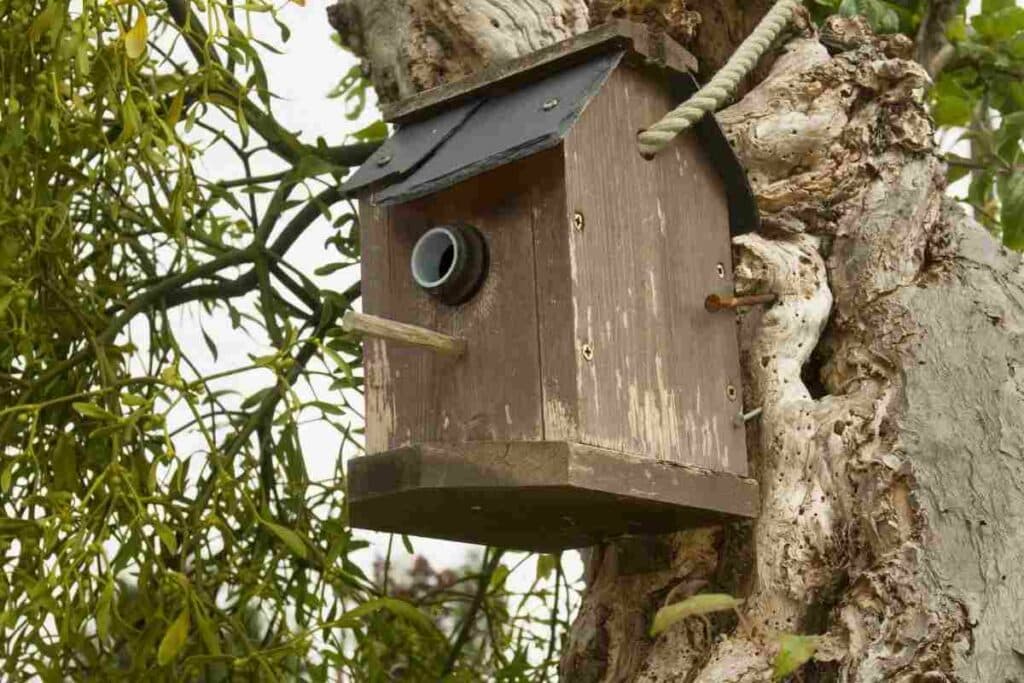If you’ve been hanging a bird nest box for a while, but no birds are visiting, you may be simply hanging it wrongly. The placement of a nest box is crucial for the birds to come by.
A nest box should ideally be 10–30 feet off the ground, depending on the birds you want to attract. Owls need a height of 10–30 feet, while small birds should be okay with 10–15 feet off the ground.
Read on to know more tips about hanging bird nest boxes, and the right heights to hang them.
How High Should a Bird Nest Box Be?
The nest box height can range from 3 to 30 feet, depending on the birds you want to attract. Each species has a preferred height, but you typically take the average and wish for the best! Here’s a roundup of the popular species and how high their nest boxes should be.
- Woodpeckers and owls: You need to place the nest box 10–17 feet high for these fellows to come by. It’s also recommended to have the larger area of the box face a tree.
- Sparrows, tits, and starlings: You should place the nest box 7–12 feet off the ground for these small birds to nest inside. It’s recommended to let it face between north and east to avoid the direct sunlight. Also, make sure there isn’t anything obstructing the clear path to the box.
- Robins and wrens: These fellows need their nesting boxes 5–7 feet from the ground.
- Kestrels: Kestrels fly as high as owls, so a height of 9–13 feet would be ideal for them.
- Nuthatches: Nuthatches can have nest boxes from 5 to 20 feet high. It’s recommended to keep the hole facing away from the wind, or else they won’t come by.
- Swallows: Swallows are small songbirds, so they’d be better off with 5–10 feet high boxes.
- Warblers: Warblers are even smaller than swallows, so you may place their nest boxes 4–6 feet high. These fellas love water, so the box should be placed close to a water stream.
- Chickadees: Chickadees need their nest boxes to be around 5–15 feet from the ground, and it’s recommended to put some wood shavings inside for them.
Tips to Correctly Place a Bird Nest Box
If you don’t place the nest box correctly, it’ll stay empty, and you don’t want that. Here are some tips to correctly place a nest box for a visiting bird.
Hide It Among Trees
Most bird species like to have privacy when it comes to nesting. These include wrens, blackbirds, robins, and flycatchers.
If you leave the nest box out in the open, it’ll most likely stay empty. That’s why you should look for a quiet spot hidden between trees or bushes to place the nest box.
Some species can do with nests that aren’t too hidden, such as tits, sparrows, and starlings. The nest still shouldn’t be out in the open, though, because they fear predators.

The only bird species that are okay with open spaces are owls, woodpeckers, and kestrels. These fellows have nothing to be afraid of, so they’ll nest in unhidden boxes safely.
Hang It Away From Pets
If you have cats or dogs, you’ll want to make sure the nest box is higher than what they can reach. Otherwise, you can expect a catastrophe if your furry little friend gets its paws on the box.
Choose the Hole Size Accordingly
If you have a 25mm hole, and you’re waiting for a woodpecker to enter the box, you have another thing coming. You need to adjust the hole size according to the bird you’re expecting.
Sparrows need at least 28mm, while tits and warblers are okay with 25mm.
Large birds, like nuthatches and house sparrows, will need at least 32mm.
Keep the Entrance Open
Many people fail to notice that birds can’t push doors. A cat may push a door if it’s getting in its way to enter, but a bird will just fly away.
That’s why you need to make sure the hole is open at all times, and that nothing is obstructing it.
Stay Away From Disturbance
Try not to hang the box anywhere close to other nests or feeders. You may find the birds aggressively fighting and quarreling, and no one needs that.
On top of that, bird mothers aren’t the most gentle; they’ll fight the nesting birds if they have to. So, try to keep the box away from disturbance altogether.
To Wrap Up
Your bird nest box can be as low as three feet from the ground, or as high as 30 feet from the ground. It all boils down to the bird you’re expecting.
It’s essential to know what birds nest in your area because they’ll determine the nest’s placement, hole size.
